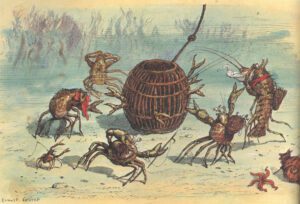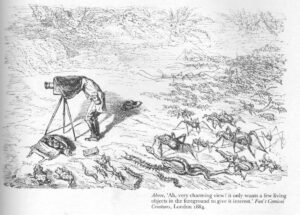Daniel Nanavati
In July 1877 several obituary notices were published about Ernest Griset. The Publishers Record stated: “Griset was very happy in illustrating the Darwinian change of an animal into a man, and of combining men and animals, something after the manner of Grandville. He was quite French in his manner, though he had lived in England from early boyhood. He was very grotesque… His death should be a loss to real caricature and comic art…” The Atheneum recorded “his first public appearance… Exhibiting pen and ink sketches in a little shop near Leicester Square, and which have so much wit, vivacity and humour that they will someday be of great value.” The Times commented on the satirical nature of his work and the expressive quality of his line. The use of animals to describe human life, from Aesop’s fables to Walt Disney in our own era, was particularly attractive to the Victorian thinker. Grandville’s insects form an orchestra, Doré’s wolf tended sheep, Landseer sentimentalised the dignity of animals in his work and Griset’s hippopotamuses danced. He was a man who loved animals, his naturalistic studies are observant and filled with life, but he also produced grotesque fantasies, some of which found their way into Punch magazine.

In the 1860s he established himself in a small bookshop near Leicester Square in Suffolk Street and sold watercolour sketches at very cheap rates. On the night of 16 October 1866, an old statue of George I on a horse, which stood in Leicester Square, was painted over with black spots; pointed horns were fixed over the horse’s ears, a large pointed cap was fixed on the King’s head, and a stave topped by a birch broom was placed against the King’s left side, where the lower part of his arm and leg were already missing. The initials A. D. G. were highlighted on both sides of the plinth. He re-recorded the vandalism in one of his surviving watercolours. Wherever Victorians were investigating animals, he was capturing events from zoo to dissection table: he drew the arrival of a single Penguin from the Falkland Islands at the zoological gardens, the first live sea lion performing tricks, the stillbirth of a hippopotamus, the caricature of the palaeontologist Sir Richard Owen – and all were published.
This once famous artist is largely forgotten, superseded by Tenniel, Lear, and Beatrix Potter. And yet to see men dissecting a kangaroo, or a mother hippopotamus weeping at her stillborn baby or a group of men hard at work taking a cast of a beached whale leaves us with an evocative view of one of the greatest efforts by a society to investigate the world of nature and strive to understand the challenge of Darwinian evolution. One of his most amusing ink drawings appeared in Fun’s Comical Creatures in 1884, in which a photographer, his head covered by the black cloth of the early tripod cameras, looks out across an empty vista while behind him are literally thousands of animals, as he mutters to himself “Ah, very charming view! It only wants a few living objects in the foreground to give it interest.”
There is however a lesson here for all of us in that sometimes, when capturing an essence of the relationship between animals and between human beings and animals and placing it in the sphere of art, we missed an essential lesson. We have all been birthed on the same planet and the animal that considers itself the most intelligent is the most utterly bloodthirsty and most completely brutal in all nature. And we miss, in anthropomorphising the animal kingdom, the very real feelings and sensibilities that other animals possess. His view of cab horses in heaven enjoying the life they could never have dreamed of when alive, is at one and the same time amusing, blissful, and tragic.

But then one of the skills of humanity is to miss so much. Ernest Griset did not care for the laudatory nature of the obituaries in 1887, as at the time he was very much alive. Thirty years later his actual death was barely noted.
Volume 35 no 2 November / December 2020

Fascinating work. Thanks for bringing him to our attention.
I was given a book by him from my sister 40 years ago. Glad you enjoyed him.